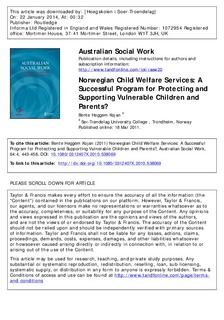Norwegian Child Welfare Services: A Successful Program for Protecting and Supporting Vulnerable Children and Parents?
Journal article, Peer reviewed
Permanent lenke
http://hdl.handle.net/11250/148678Utgivelsesdato
2011-03-18Metadata
Vis full innførselSamlinger
- Institutt for sosialt arbeid [1392]
Originalversjon
Kojan, B. H. (2011). Norwegian Child Welfare Services: A Successful Program for Protecting and Supporting Vulnerable Children and Parents? Australian Social Work, 64(4), 443-458. 10.1080/0312407X.2010.538069Sammendrag
This paper describes and analyses the program of Child Welfare Services (CWS) in Norway, using primary sources, aggregated data from Statistics Norway (SSB) and data from a recent study of 715 parents in contact with CWS. These data show that Norway's program orientation is on support, prevention, and early intervention, policies relevant to the emerging Australian policy context. Many of these services were beneficial for the general welfare of the children's family with over three- quarters of the children registered as clients in the Norwegian CWS receiving only supportive services during 2008. On the contrary, Australian systems primarily aim to identify and protect children under (possible) risk of abuse or neglect. Also, the survey data shows that families in contact with CWS are different to the general population in important ways, including family structure/demographics, socioeconomic characteristics, and physical and mental health. The results demonstrated that most of the parents agreed to contact CWS, and many were satisfied with the help they received. The data demonstrate that the Norwegian CWS respond to the welfare needs of vulnerable and marginalised families. Possible implications the Norwegian system might have for the children and parents who are accessing services are discussed.
Beskrivelse
This is an electronic version of an article published in the Australian Social Work © 2011 Copyright Taylor & Francis; Australian Social Work is available online at www.tandfonline.com http://www.tandfonline.com/doi/full/10.1080/0312407X.2010.538069
